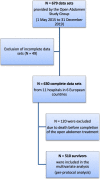Factors influencing the fascial closure rate after open abdomen treatment: Results from the European Hernia Society (EuraHS) Registry : Surgical technique matters
- PMID: 33219419
- PMCID: PMC8881440
- DOI: 10.1007/s10029-020-02336-x
Factors influencing the fascial closure rate after open abdomen treatment: Results from the European Hernia Society (EuraHS) Registry : Surgical technique matters
Abstract
Purpose: Definitive fascial closure is an essential treatment objective after open abdomen treatment and mitigates morbidity and mortality. There is a paucity of evidence on factors that promote or prevent definitive fascial closure.
Methods: A multi-center multivariable analysis of data from the Open Abdomen Route of the European Hernia Society included all cases between 1 May 2015 and 31 December 2019. Different treatment elements, i.e. the use of a visceral protective layer, negative-pressure wound therapy and dynamic closure techniques, as well as patient characteristics were included in the multivariable analysis. The study was registered in the International Clinical Trials Registry Platform via the German Registry for Clinical Trials (DRK00021719).
Results: Data were included from 630 patients from eleven surgical departments in six European countries. Indications for OAT were peritonitis (46%), abdominal compartment syndrome (20.5%), burst abdomen (11.3%), abdominal trauma (9%), and other conditions (13.2%). The overall definitive fascial closure rate was 57.5% in the intention-to-treat analysis and 71% in the per-protocol analysis. The multivariable analysis showed a positive correlation of negative-pressure wound therapy (odds ratio: 2.496, p < 0.001) and dynamic closure techniques (odds ratio: 2.687, p < 0.001) with fascial closure and a negative correlation of intra-abdominal contamination (odds ratio: 0.630, p = 0.029) and the number of surgical procedures before OAT (odds ratio: 0.740, p = 0.005) with DFC.
Conclusion: The clinical course and prognosis of open abdomen treatment can significantly be improved by the use of treatment elements such as negative-pressure wound therapy and dynamic closure techniques, which are associated with definitive fascial closure.
Keywords: Abdominal compartment syndrome; Abdominal trauma; Burst abdomen; Fascial closure; Hernia; NPWT; Open abdomen; Peritonitis; VAC.
© 2020. The Author(s).
Conflict of interest statement
The authors declare no conflict of interest. No funding was received for this work.
Figures




Similar articles
-
The Open Abdomen Route by EuraHS: introduction of the data set and initial results of procedures and procedure-related complications.Hernia. 2017 Apr;21(2):279-289. doi: 10.1007/s10029-017-1572-4. Epub 2017 Jan 16. Hernia. 2017. PMID: 28093615
-
Delayed closure of open abdomen in septic patients is facilitated by combined negative pressure wound therapy and dynamic fascial suture.Surg Endosc. 2014 Mar;28(3):735-40. doi: 10.1007/s00464-013-3251-6. Epub 2013 Oct 23. Surg Endosc. 2014. PMID: 24149855 Clinical Trial.
-
Early Initiation of a Standardized Open Abdomen Treatment With Vacuum Assisted Mesh-Mediated Fascial Traction Achieves Best Results.Front Surg. 2021 Feb 9;7:606539. doi: 10.3389/fsurg.2020.606539. eCollection 2020. Front Surg. 2021. PMID: 33634162 Free PMC article.
-
International consensus conference on open abdomen in trauma.J Trauma Acute Care Surg. 2016 Jan;80(1):173-83. doi: 10.1097/TA.0000000000000882. J Trauma Acute Care Surg. 2016. PMID: 27551925 Review.
-
Vacuum-assisted wound closure and mesh-mediated fascial traction for temporary closure in open abdomen: A single-arm meta-analysis.World J Surg. 2024 Oct;48(10):2391-2399. doi: 10.1002/wjs.12336. Epub 2024 Sep 7. World J Surg. 2024. PMID: 39243381
Cited by
-
Use of a visceral protective layer prevents fistula development in open abdomen therapy: results from the European Hernia Society Open Abdomen Registry.Br J Surg. 2023 Nov 9;110(12):1607-1610. doi: 10.1093/bjs/znad163. Br J Surg. 2023. PMID: 37311688 Free PMC article. No abstract available.
-
The use of biosynthetic mesh in giant hiatal hernia repair: is there a rationale? A 3-year single-center experience-author's reply.Hernia. 2021 Oct;25(5):1385. doi: 10.1007/s10029-020-02329-w. Epub 2020 Nov 9. Hernia. 2021. PMID: 33165703 No abstract available.
-
Delayed Closure of Open Abdomen in Septic Patients Treated With Negative Pressure Vacuum Therapy and Dynamic Sutures: A 10-Years Follow-Up on Long-Term Complications.Front Surg. 2021 Jan 15;7:611905. doi: 10.3389/fsurg.2020.611905. eCollection 2020. Front Surg. 2021. PMID: 33521047 Free PMC article.
-
Artificial Intelligence Versus Human Systematic Literature Review Into Negative-pressure Wound Therapy in Plastic Surgery.Plast Reconstr Surg Glob Open. 2025 Apr 18;13(4):e6699. doi: 10.1097/GOX.0000000000006699. eCollection 2025 Apr. Plast Reconstr Surg Glob Open. 2025. PMID: 40256345 Free PMC article.
-
Comment to: the use of biosynthetic mesh in giant hiatal hernia repair: is there a rationale? A 3-year single-center experience.Hernia. 2020 Dec;24(6):1409. doi: 10.1007/s10029-020-02287-3. Epub 2020 Aug 20. Hernia. 2020. PMID: 32816153 No abstract available.
References
-
- Karhof S, Haverkort M, Simmermacher R, Hietbrink F, Leenen L, van Wessem K. Underlying disease determines the risk of an open abdomen treatment, final closure, however, is determined by the surgical abdominal history. Eur J Trauma Emerg Surg. 2019 doi: 10.1007/s00068-019-01205-2. - DOI - PMC - PubMed
Publication types
MeSH terms
LinkOut - more resources
Full Text Sources

